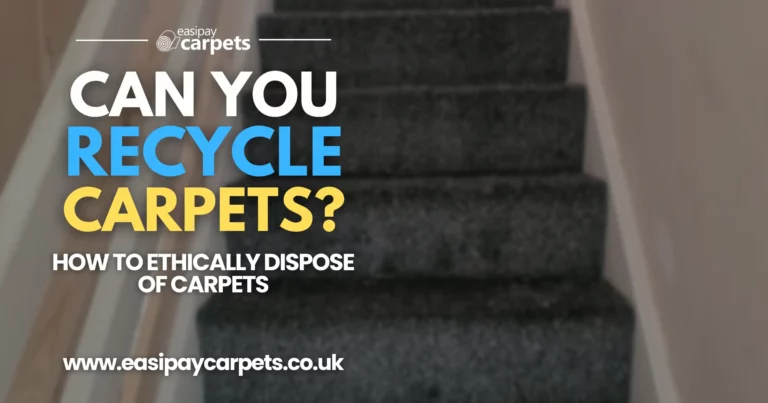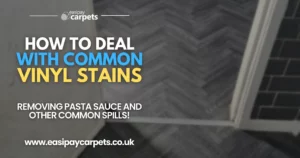

Can You Recycle Carpet? Here's How To Dispose Of Your Old Carpets
Carpets are a popular flooring choice in many homes, but when it’s time for an upgrade, disposing of old carpets can be a challenge. If you’re wondering, “Can carpets be recycled?” or “Can I take carpet to a recycling centre?”, this guide will provide you with all the answers. We’ll explore various ways to dispose of old carpets, whether they can be recycled or reused, and tips for safely removing them from a room.
Can Carpets Be Recycled?
Yes, carpets can be recycled, but the process is more complex than recycling other household items like plastic or paper. Carpets are made from a mix of materials, such as nylon, polyester, and polypropylene, as well as backing materials like latex and jute, which makes the recycling process challenging. However, with the growing focus on sustainability, many recycling centres now accept carpets and recycle them into new products.
What Happens During Carpet Recycling?
Separation of Materials:
- Description: During recycling, carpets are first shredded to separate the fibres from the backing. The fibres, which may be made of nylon, polyester, or polypropylene, are then sorted and cleaned.
- Purpose: The separation process allows each material to be processed and repurposed into new products.
Processing and Repurposing:
- Description: The separated materials are processed to create new products. For example, nylon can be turned into new carpet fibres, while polypropylene can be repurposed into plastic products or outdoor decking.
- Purpose: Recycling reduces waste and the need for virgin materials, contributing to environmental sustainability.
Alternative Uses:
- Description: Some recycled carpets are used for alternative purposes, such as erosion control, insulation, or backing for new carpets.
- Purpose: Repurposing carpets helps reduce landfill waste and promotes circular economy practices.
How to Dispose of Old Carpet
Disposing of old carpets responsibly is crucial for minimizing environmental impact. Here are some methods for carpet disposal:
1. Recycling Centres
Tip: Many recycling centres accept old carpets, but it’s important to check with your local centre to see if they have the facilities to process carpets. Some centres may charge a fee for carpet recycling.
Why It Matters: Recycling carpets helps reduce landfill waste and allows the materials to be repurposed into new products.
2. Carpet Recycling Programs
Tip: Look for carpet recycling programs in your area, such as Carpet Recycling UK, which partners with recycling facilities to provide carpet recycling options to homeowners.
Why It Matters: These programs are specifically designed to handle carpet recycling, making it easier to dispose of carpets sustainably.
3. Bulk Waste Collection Services
Tip: Some local councils offer bulk waste collection services that accept carpets. Contact your local council to arrange a pick-up or find out the guidelines for carpet disposal.
Why It Matters: Bulk waste services can handle large items like carpets, ensuring they are disposed of properly.
4. Donate or Repurpose
Tip: If your carpet is still in good condition, consider donating it to a charity, school, or community group. Alternatively, repurpose it for other uses around the home, such as doormats, pet bedding, or insulation.
Why It Matters: Donating or repurposing carpets extends their life and keeps them out of landfills.
Can I Take Carpet to a Recycling Centre?
Yes, you can take carpet to a recycling centre, but you should check with the centre in advance. Not all recycling centres are equipped to handle carpet recycling, and some may have specific guidelines or fees for carpet disposal.
Steps to Recycle Carpets at a Recycling Centre:
Contact the Recycling Centre:
Call ahead or check the recycling centre’s website to confirm they accept carpets and inquire about any fees or requirements.Prepare the Carpet for Recycling:
Remove any nails, staples, or tacks from the carpet before taking it to the recycling centre. This will make the recycling process easier and safer.Transport the Carpet:
Roll up the carpet tightly and secure it with string or tape for easy transport to the recycling centre.
Can I Put Carpet in My Waste Bin?
No, carpets should not be placed in your regular waste bin. Carpets are considered bulky waste and cannot be processed through standard waste management systems. Instead, they should be taken to a recycling centre, disposed of through bulk waste collection services, or recycled through a carpet recycling program.
Why You Shouldn’t Use a Waste Bin for Carpets:
- Size and Weight: Carpets are too large and heavy for regular waste bins, and disposing of them this way can lead to fines.
- Environmental Impact: Carpets in waste bins end up in landfills, where they take up significant space and do not decompose easily, contributing to environmental pollution.
Can Old Carpet Be Recycled Into New Carpet?
Yes, old carpet can be recycled into new carpet, particularly when it is made from nylon fibres. Nylon carpets are highly recyclable because the fibres can be broken down and reformed into new carpet yarns.
How the Process Works:
Collection and Sorting:
Carpets are collected and sorted by fibre type. Nylon carpets are separated from other types, as they are the most suitable for recycling.Cleaning and Processing:
The nylon fibres are cleaned, processed, and broken down into their raw material form. This material is then used to create new carpet yarns.Manufacturing New Carpet:
The recycled nylon yarns are used to produce new carpets, which are often labelled as “recycled content carpets.”
Benefits of Recycling Carpet into New Carpet:
- Reduces Waste: Recycling carpets into new carpets helps divert waste from landfills.
- Saves Resources: It reduces the need for virgin materials, conserving natural resources and reducing environmental impact.
What Can Old Carpet Be Used For?
Old carpet can be repurposed in various ways, providing value beyond its original use:
Rugs and Mats:
Cut old carpet into smaller pieces to create doormats, rugs, or runners for hallways or entryways.Pet Bedding and Scratching Posts:
Use old carpet to create comfortable pet beds or scratching posts for cats.Garden Pathways and Erosion Control:
Lay strips of old carpet in gardens to create pathways or use them for erosion control on slopes.Insulation:
Old carpets can be used as insulation in sheds, garages, or kennels to help retain heat.Protective Padding:
Use old carpet as protective padding in workshops, garages, or under heavy furniture to prevent scratches on floors.
How Do I Remove an Old Carpet from a Room?
Removing an old carpet from a room requires some preparation and the right tools. Here’s a step-by-step guide:
1. Clear the Room
Step: Remove all furniture and obstacles from the room to provide clear access to the carpet.
Why It Matters: Clearing the room ensures safety and allows for easy removal of the carpet.
2. Cut the Carpet into Manageable Sections
Step: Use a utility knife to cut the carpet into smaller sections. Start by cutting along the seams and then cut across the width or length of the room.
Why It Matters: Cutting the carpet into smaller pieces makes it easier to handle, roll, and transport.
3. Remove the Carpet from the Tack Strips
Step: Starting from one corner, pull the carpet away from the tack strips along the edges of the room. Wear gloves to protect your hands from the sharp strips.
Why It Matters: Tack strips hold the carpet in place, and removing it from them is necessary to lift the carpet.
4. Roll Up the Carpet Sections
Step: Roll each section of carpet tightly and secure it with tape or string to make it easier to carry.
Why It Matters: Rolled sections are easier to move and transport to a recycling centre or disposal site.
5. Remove the Carpet Padding
Step: Remove the carpet padding underneath and dispose of it separately, following the same steps of cutting, rolling, and securing.
Why It Matters: Carpet padding may need to be disposed of differently from the carpet itself, so keep it separate.
6. Clean the Subfloor
Step: Once the carpet and padding are removed, clean the subfloor thoroughly to prepare it for new flooring or leave it bare.
Why It Matters: A clean subfloor ensures a smooth installation of new flooring and prevents dirt and debris buildup.
Conclusion
Carpet recycling and proper disposal are essential steps toward reducing environmental impact and promoting sustainable living. While not all recycling centres accept carpets, many do, and there are specialized programs that make recycling old carpets easier. By understanding how to dispose of old carpet, what can be recycled or repurposed, and the steps for safely removing carpets from a room, you can make informed decisions that benefit both your home and the environment.
Whether recycling, repurposing, or donating, there are several responsible options for dealing with old carpets. And by following these tips, you can ensure a smooth carpet removal process and a more sustainable approach to home improvement.
Easipay Carpets can help you get brand new flooring without the high up-front cost – by simply letting you spread the cost of the flooring over time instead. There’s no interest on our plans so you aren’t spending a penny more than you would buying it outright and we include underlay, door trims, carpet grippers and laminate beading for free. Prices start from just £10 per week!
It starts with a free home appointment and quote, to get booked in at a time that suits you, tap the “Get Started” button below and fill out the contact form!
Still Got Questions? Here's 10 FAQs!
Dispose of old carpet by taking it to a recycling centre, using a carpet recycling program, arranging bulk waste collection, or donating it if it is in good condition.
Yes, many recycling centres accept carpets, but it’s best to check with your local centre for specific guidelines and fees.
No, carpets are considered bulky waste and should not be placed in regular waste bins. Use recycling centres or bulk waste collection services instead.
Yes, old carpet, especially nylon carpets, can be recycled into new carpet fibres through specialized recycling processes.
Old carpet can be repurposed as rugs, pet bedding, garden pathways, insulation, and protective padding in workshops or garages.
Remove old carpet by clearing the room, cutting the carpet into manageable sections, pulling it from tack strips, rolling it up, and disposing of it properly.
Some recycling centres or programs may charge a fee for carpet recycling due to the complex process involved in separating and processing the materials.
While some people use old carpet for weed control in gardens, it’s generally not recommended due to potential chemical leaching and degradation.
Check with local environmental organizations or search for programs like Carpet Recycling UK to find carpet recycling options in your area.
You’ll need a utility knife, pliers, gloves, a scraper, and a carpet stretcher to safely remove and dispose of an old carpet.




